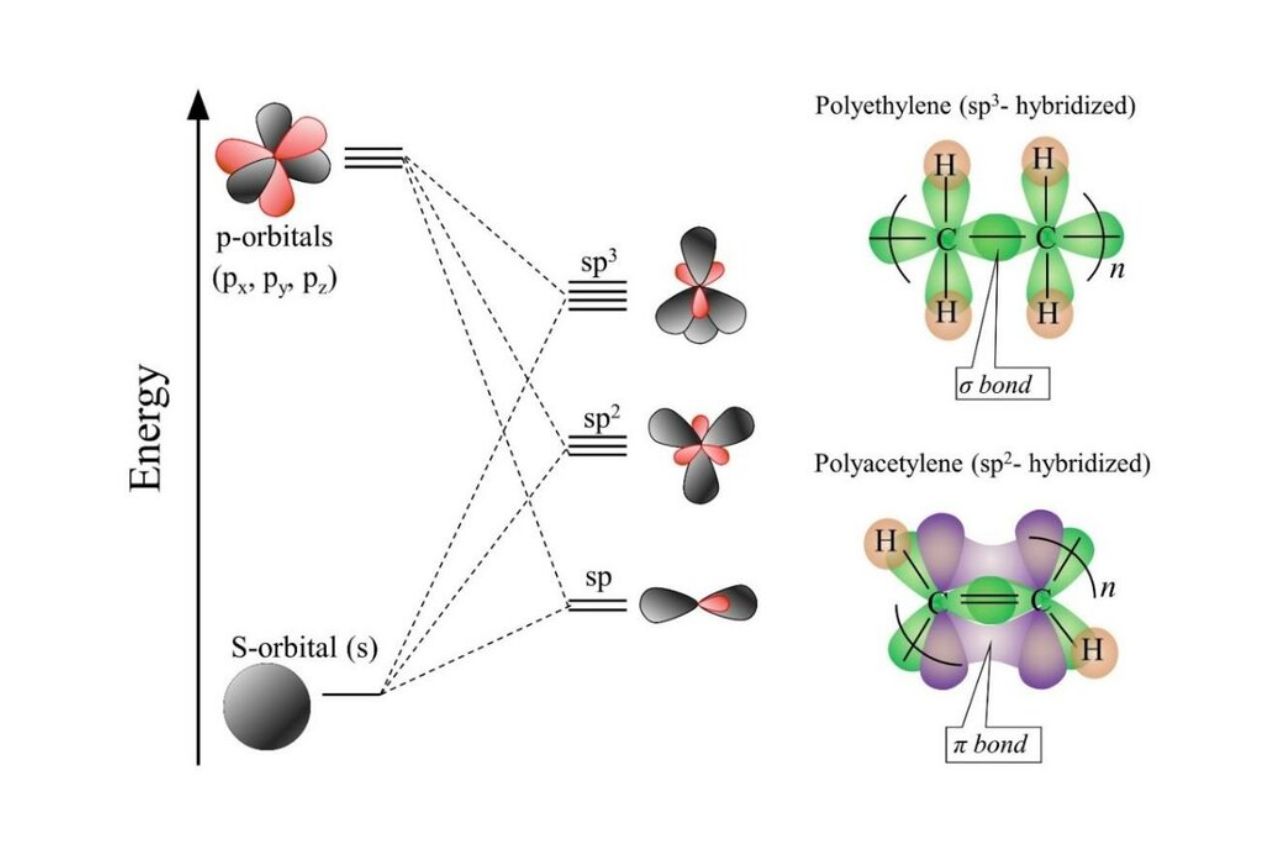
Orbital hybridization is a fundamental concept in chemistry that revolutionized our understanding of chemical bonding. It plays a crucial role in determining the molecular structure and characteristics of various compounds. By combining atomic orbitals, hybrid orbitals are formed, which have unique shapes and orientations that contribute to the overall stability and reactivity of molecules.
In this article, we will explore 20 fascinating facts about orbital hybridization, shedding light on its significance in understanding the properties of organic and inorganic compounds. From the historical context of its discovery to its applications in different fields of chemistry, these facts will showcase the versatility and impact of orbital hybridization on the world of science.
Key Takeaways:
- Orbital hybridization explains how atoms mix their orbitals to form new shapes, influencing the bonding and geometry of molecules, like a recipe for creating different molecular structures in chemistry.
- Understanding orbital hybridization helps scientists design better drugs, study material properties, and explain molecular shapes, like a secret code that unlocks the mysteries of chemistry.
The Discovery of Orbital Hybridization
Orbital hybridization was first proposed by Linus Pauling in He developed this theory to explain the molecular geometry of molecules.
The Concept of Atomic Orbitals
Atomic orbitals are regions around an atom’s nucleus where electrons are likely to be found. Orbital hybridization involves the mixing of these atomic orbitals to form new hybrid orbitals with different shapes and properties.
Types of Orbital Hybridization
There are three main types of orbital hybridization: sp, sp2, and spThese hybrid orbitals are formed by mixing s and p orbitals in various combinations.
Role of Orbital Hybridization in Bonding
Orbital hybridization plays a crucial role in determining the type of chemical bonding in molecules. It helps explain the formation of single, double, and triple bonds.
sp Hybridization in Linear Molecules
sp hybridization occurs when one s and one p orbital combine to form two sp hybrid orbitals. These orbitals are arranged in a linear fashion and commonly found in molecules like carbon monoxide (CO) and hydrogen cyanide (HCN).
sp2 Hybridization in Trigonal Planar Molecules
sp2 hybridization involves the combination of one s and two p orbitals, resulting in three sp2 hybrid orbitals. These orbitals are arranged in a trigonal planar geometry and can be observed in molecules like boron trifluoride (BF3) and ethylene (C2H4).
sp3 Hybridization in Tetrahedral Molecules
sp3 hybridization occurs when one s and three p orbitals mix, giving rise to four sp3 hybrid orbitals. These orbitals are arranged in a tetrahedral geometry and are commonly found in molecules like methane (CH4) and ammonia (NH3).
Importance of Orbital Hybridization in Organic Chemistry
Orbital hybridization is a fundamental concept in organic chemistry as it helps explain the shapes and properties of organic molecules. It provides insights into the stability and reactivity of organic compounds.
Role of Dipoles in Orbital Hybridization
Orbital hybridization influences the molecular dipole moment, which is a measure of the molecule’s overall polarity. The arrangement of hybrid orbitals affects the distribution of electrons, leading to polar or nonpolar molecules.
sp3d Hybridization in Trigonal Bipyramidal Molecules
In trigonal bipyramidal molecules, such as phosphorus pentachloride (PCl5) and sulfur hexafluoride (SF6), the central atom undergoes sp3d hybridization. This results in five hybrid orbitals arranged in a trigonal bipyramidal geometry.
Characteristics of sp3d2 Hybridization
sp3d2 hybridization occurs in octahedral molecules like sulfur hexafluoride (SF6). The central atom forms six hybrid orbitals, resulting in an octahedral arrangement.
Role of Orbital Hybridization in Resonance
Orbital hybridization helps explain the phenomenon of resonance in molecules. It allows for the delocalization of electrons and the stabilization of molecular structures.
Application of Orbital Hybridization in Drug Design
The understanding of orbital hybridization is essential in drug design. By predicting the molecular geometry and bond properties, scientists can design more effective and target-specific drugs.
Hybrid Orbitals in Organic Reaction Mechanisms
Hybrid orbitals play a crucial role in organic reaction mechanisms. They determine the bonding and geometry changes during chemical reactions, leading to the formation of new compounds.
The Importance of Orbital Hybridization in Material Science
Orbital hybridization is crucial in material science, as it determines the electronic and structural properties of materials. It allows scientists to manipulate properties like conductivity, strength, and magnetic behavior.
The Influence of Orbital Hybridization on Molecular Shape
Orbital hybridization directly influences the shape and geometry of molecules. It explains why some molecules are linear, while others are bent, trigonal planar, or tetrahedral.
Hybrid Orbitals and Molecular Bond Angles
The formation of hybrid orbitals affects the bond angles in a molecule. The different hybridization types lead to specific bond angles, such as 180° in linear molecules and 109.5° in tetrahedral molecules.
Limitations of Orbital Hybridization Theory
While orbital hybridization is a valuable tool for understanding molecular structures, it does have some limitations. It may not fully explain certain complex molecular geometries and bond angles.
Orbital Hybridization and Molecular Orbitals
The hybrid orbitals formed through orbital hybridization can further combine to form molecular orbitals. These molecular orbitals contribute to the overall electronic structure and properties of the molecule.
Experimental Evidence Supporting Orbital Hybridization
The concept of orbital hybridization is supported by various experimental techniques, including X-ray crystallography, spectroscopy, and electron diffraction. These techniques provide direct evidence of the hybridization of atomic orbitals.
Overall, understanding orbital hybridization is crucial in the field of chemistry. It helps explain the shapes, bonding, and properties of molecules, providing a foundation for further advancements in various scientific disciplines.
Conclusion
In conclusion, orbital hybridization is a fundamental concept in the field of chemistry that helps us understand the unique bonding arrangements and shapes of molecules. The different types of hybrid orbitals – sp, sp², sp³, and sp³d – allow for the formation of various molecular geometries and contribute to the stability and reactivity of compounds. Understanding orbital hybridization is crucial for predicting chemical properties and understanding the behavior of organic and inorganic substances.
FAQs
1. What is orbital hybridization?
Orbital hybridization refers to the mixing of atomic orbitals to form new hybrid orbitals with different properties. It helps explain the observed molecular geometries and bonding arrangements in chemical compounds.
2. How does orbital hybridization affect molecular shape?
The type of hybrid orbitals used determines the molecular shape. For example, sp hybridization leads to linear geometries, while sp² results in trigonal planar shapes, and sp³ gives rise to tetrahedral geometries.
3. What are the applications of orbital hybridization?
Orbital hybridization is crucial in understanding the behavior of organic and inorganic compounds. It helps in predicting chemical properties, such as bond angles, bond lengths, and molecular polarity, which are vital in drug design, material science, and environmental studies.
4. Can orbital hybridization be observed experimentally?
Orbital hybridization cannot be directly observed, but its effects can be inferred by studying molecular geometries, bond angles, and bond lengths using techniques such as X-ray crystallography and spectroscopy.
5. Are all atoms capable of hybridization?
No, not all atoms can hybridize their orbitals. Hybridization generally occurs in atoms that have a central atom capable of forming multiple bonds, such as carbon, nitrogen, and oxygen.
6. How does hybridization affect the reactivity of molecules?
Hybridization can affect the stability and reactivity of molecules by influencing the arrangement of electron density and the availability of unhybridized orbitals for bonding and chemical reactions.
7. Can orbital hybridization occur in transition metal complexes?
Yes, orbital hybridization can occur in transition metal complexes. In these complexes, d and s orbitals can mix to form a variety of hybrid orbitals, leading to the formation of complex geometries and unique bonding interactions.
8. How is orbital hybridization related to molecular orbital theory?
Both orbital hybridization and molecular orbital theory involve the combination of atomic orbitals. While orbital hybridization focuses on the localized bonding in specific atoms, molecular orbital theory considers the delocalized nature of electrons across the entire molecule.
9. Can hybrid orbitals overlap with atomic orbitals?
Yes, hybrid orbitals can overlap with atomic orbitals to form sigma and pi bonds in covalent bonding. This overlap plays a crucial role in determining the strength and stability of chemical bonds.
10. Is orbital hybridization limited to carbon compounds?
No, orbital hybridization is not limited to carbon compounds. While carbon demonstrates the most diverse forms of hybridization, other elements, such as nitrogen, oxygen, and sulfur, can also undergo orbital hybridization to form unique bonding arrangements in their compounds.
Orbital hybridization plays a crucial role in determining molecular structure and reactivity. Understanding its intricacies can help you grasp the fundamentals of chemistry. If you're curious about how electrons are distributed in atoms, explore the surprising facts about electron configuration notation. Dive deeper into the world of molecular structure by discovering the surprising facts about molecular geometry. For a comprehensive understanding of how atoms interact, don't miss the unbelievable facts about chemical bonding. Expand your knowledge of chemistry and unlock the secrets of the molecular world.
Was this page helpful?
Our commitment to delivering trustworthy and engaging content is at the heart of what we do. Each fact on our site is contributed by real users like you, bringing a wealth of diverse insights and information. To ensure the highest standards of accuracy and reliability, our dedicated editors meticulously review each submission. This process guarantees that the facts we share are not only fascinating but also credible. Trust in our commitment to quality and authenticity as you explore and learn with us.


